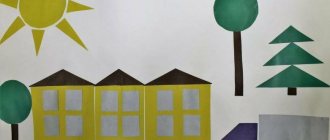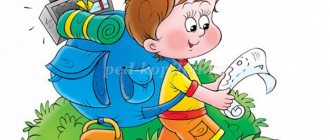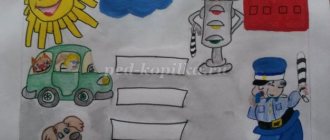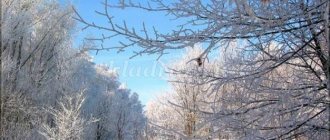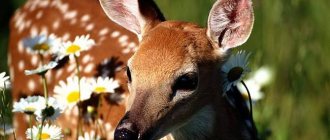Goal: familiarization with the mnemonic method.
Tasks:
Educational:
- introduce mnemonics as an element of mnemonics;
- practice composing sentences of 3-5 words based on symbols.
Educational:
- develop imagination and creative activity;
- form associative thinking;
- develop mental operations of analysis and synthesis;
- improve visual perception and attention.
Educational:
- cultivate a desire to communicate and make friends with peers.
Materials and equipment : module or chairs for simulating a ship, a pointer, a bottle with a letter, a mnemonic track, mnemonic squares, balloons, Hawaiians (flower beads), an audio recording with the song “Chunga-Changa” and the sounds of the river.
PROGRESS OF THE CLASS
1.Organizational moment
Educator: Guys, what time of year is it now?
Children: Summer
Educator: What's the weather like today?
Children: Hot, warm, sunny, etc.
Educator: In such hot weather, it’s nice to spend time on the river, and I invite you to a river boat trip. Go on deck.
Children, to the sound of the surf, walk along a ribbed board “ladder” and sit on an improvised deck.
2. Introduction to the topic
Educator: Breathe in the cool river air. Look at the blue surface of the river, listen to the waves splashing. Look, there’s something floating in the distance (the teacher pulls out a bottle covered with algae and shells by the rope) Let’s see what’s inside (pulls out a letter)
3. Consideration of the mnemonic table
Educator: What do you think this is? (pulls out a scroll and unfolds it) Children: message, map, etc.
Educator: Maybe this is a letter? But it is unusual, it consists of pictures. Let's try to decipher the pictures and read the letter.
Educator: Look at the first symbol picture. Who do you think sent us the letter?
Children: These are children: a boy and a girl.
Educator: What do they want to tell us about themselves? Look at the pictures one by one.
With the help of the teacher's leading questions, children compose a story using reference pictures.
Children: They live on a desert island. They have warm weather, it’s hot, the sun is shining brightly. Crabs, fish and turtles live on the island, and various fruits grow: pineapples, bananas. Children on the island love to play ball, badminton and swim in the sea.
Educator: Look how the children finished their message. What are they telling us? What do they usually write at the end of a letter?
Children: Let's be friends! Write us a reply. Goodbye!
4. Physical education break
Educator: It seems to me that I know these guys. They are from the island of Chunga Changa. Would you like to dance their favorite dance? Here are the islanders' jewelry (children wear flower beads and Hawaiian shirts around their necks). Come out onto the deck.
These signal cards will help us learn a cheerful dance (the teacher shows the card and explains the movement).
| circular movements with hands, “motor” |
| raise your arms up to the right, then to the left |
| step left and right, arms raised up at right angles |
Let's first perform these movements without music, and now with music. Be very careful, watch the symbols change.
The teacher randomly shows symbol cards, and the children perform a dance movement in accordance with it. At the last chorus, the symbols are removed and the children dance in free form.
4. Work on drawing up proposals.
Educator: Well, I think the kids from the island of Chunga-Changa will really like the way we dance.
But they invited us to be friends, and are waiting for an answer. Are you ready to write them a letter?
Children: Yes
Educator: To do this, break into pairs and think together about what you would like to tell your new friends? Choose a picture that will help tell the story.
Children, working in pairs, choose any symbol picture on the table and use it to make a sentence.
Educator: Let's start our letter. I propose to do this the same way as our friends (attaches a picture of a boy and a girl on the board). What did we say?
Children: Hello, we are children too - boys and girls.
Educator: Now continue, what else can you tell our new friends.
(Children say their sentences based on symbols. The teacher lays them out on the board: We live in the city. We love to play sports, ride a bike downhill, draw. We have pets: cats, dogs, birds, etc. )
Educator: How will we end our letter-message? How do we say goodbye, what symbols and pictures will we use to indicate this?
Children: Let's be friends! Waiting for an answer. Goodbye!
The teacher adds an image of an envelope and a hand.
5.End of class
Educator: Our letter is ready, now it can be sent, but how to do it?
Children: On a plane, throw it in a bottle and send it down the river, etc.
Educator: All the proposed options are wonderful, but I want to suggest this method .
I have wonderful friends
Light, nimble, useful.
We will tie the letter to them,
We will show them the right path.
(Children tie the letter to balloons and release it into the sky)
Fly into the sky, balls,
Bring the news to your friends!
6. Summing up
Educator: I hope that new friends will receive the letter and will definitely answer or come to visit, but our walk has come to an end, it’s time to return to the shore.
Did you enjoy our trip? What do you remember most? What new things have you learned? What did you find difficult?
As a souvenir of our walk, I want to give you unusual beads made of flowers, so that you can tell about your new friends at home and teach the dance from the island of Chunga-Changa to your parents and friends.
Abstract of GCD for speech development in kindergarten. Senior group
ECD for children of the senior group on speech development “Guests have come to us”
Goal: Stimulating children's speech activity. Program objectives: • Enrich children's vocabulary with the help of verbal and speech games. • Develop the ability to observe communication ethics in conditions of collective interaction, to notice and kindly correct mistakes in the speech of peers. • Be able to construct your statement, focusing on the task of communication, using elements of evidence, generalizations based on characteristics, anonymous names. • Foster a desire for new achievements. /The teacher and the children greet guests at the entrance/. Teacher: Guys, I told you that guests will come to us soon. Here they come. We are very glad to see you. We talked a lot about the meeting and decided to start communicating with a game of greetings. Are you ready to play with us? The game has a rule, and the guys and I know that if there are rules, then they are (You need to follow, observe, act). And the rule is this: listen carefully to the text and perform actions in accordance with it. Let's say hello with your hands. Let's say hello with your legs. Let's say hello with your eyes. Let's say hello with our mouths. There was joy all around! Teacher: Guys, the guests came to us for a reason, they brought just such a box. What do you think might be in it? (Children's assumptions). How can you find out? (Open). Guys, our guests also have a rule. Open the box only when you complete the tasks and then a surprise awaits you. What is a surprise? (Surprise, joy). What decision do we make? (Children decide to start completing tasks). /The teacher offers to sit on chairs. Draws attention to the children’s posture, to the fact that they need to be very attentive, not interrupt each other when answering, and help/. TASK No. 1 “Listen to the story and answer the questions.” N. Sazonova “Warm feeder”. It was winter. Vanya was coming from kindergarten. He carried a gingerbread in his hand. The boy did not notice how he dropped the mitten and gingerbread. Vanya came home - no mittens, no gingerbread. Where are they? And at this time the sparrows flew onto the gingerbread, pecking at it and chirping. They had already eaten all the gingerbread and began to peck at the mitten. Vanya looks out the window at his mitten and thinks: “What a warm bird feeder it turned out to be.” • What is the name of the story? • Where did Vanya come from? • What was he carrying? • What didn’t Vanya notice? • Who pecked the gingerbread? • What did Vanya think? We have completed the first task, let's move on to the next one. TASK No. 2 “Say a word with the opposite meaning.” Teacher: To complete this task, let’s stand in a circle. I will tell each of you a word, and you say the opposite in meaning. (Good - evil, good - bad, friend - enemy, day - night, peace - war, truth - lies, rich - poor, heavy - light, thick - thin, high - low, wet - dry, big - small, laughs - cries, speak - remain silent, brave - cowardly, white - black). Teacher: Very good and we are completing the next task. TASK No. 3 “Formation of phrases.” Guys, let's go and sit on the chairs. Guys, why are we doing tasks? What is a surprise? I want to remind you that there is no need to shout from your seat, but we speak only after we raise our hand. The next task is this: you need to create a new expression from the given words. For example: “A house made of snow is a snow house.” • Wool mitten. • Wooden spoon. • Path from the forest. • Leather gloves. • Brick house. • Slide made of ice. • The machine is made of plastic. Teacher: Well done. There is one last task left. TASK No. 4 “Name the common characteristic of objects?” Guys, there are cards on the floor with circles of different colors on them - these are “houses”. If they are different colors, what do they mean? (Multicolored). You have circles of the same colors in your hands, each of you go to your house. And now the task. You need to take a card, look at it carefully and say what is drawn on the card and what these objects have in common. /The cards show: • Boots, pacifier, ball (rubber). • Slide, snowman, snowflake (snow). • Burrow, house, hollow (dwelling). • Apple, button, tomato (shape). Teacher: Well, we completed the tasks. Tell me, was it difficult to complete the tasks? What was the most interesting task? What awaits us now? (Surprise) What is this? (Joy, surprise). Let's all go open the box. /Children find sweet prizes/.
We recommend watching:
Summary of a subgroup GCD on speech development in the senior group. Summary of a lesson on speech development in the senior group. My Sevastopol Summary of a lesson on speech development in the senior group with a presentation. Bazhov “Silver Hoof” Summary of educational activities on speech development in the senior group. Retelling of Tolstoy's story "Clever Jackdaw"
Similar articles:
Summary of a lesson on speech development in the senior group. Retelling of a work of art. Tolstoy "Two Comrades"
